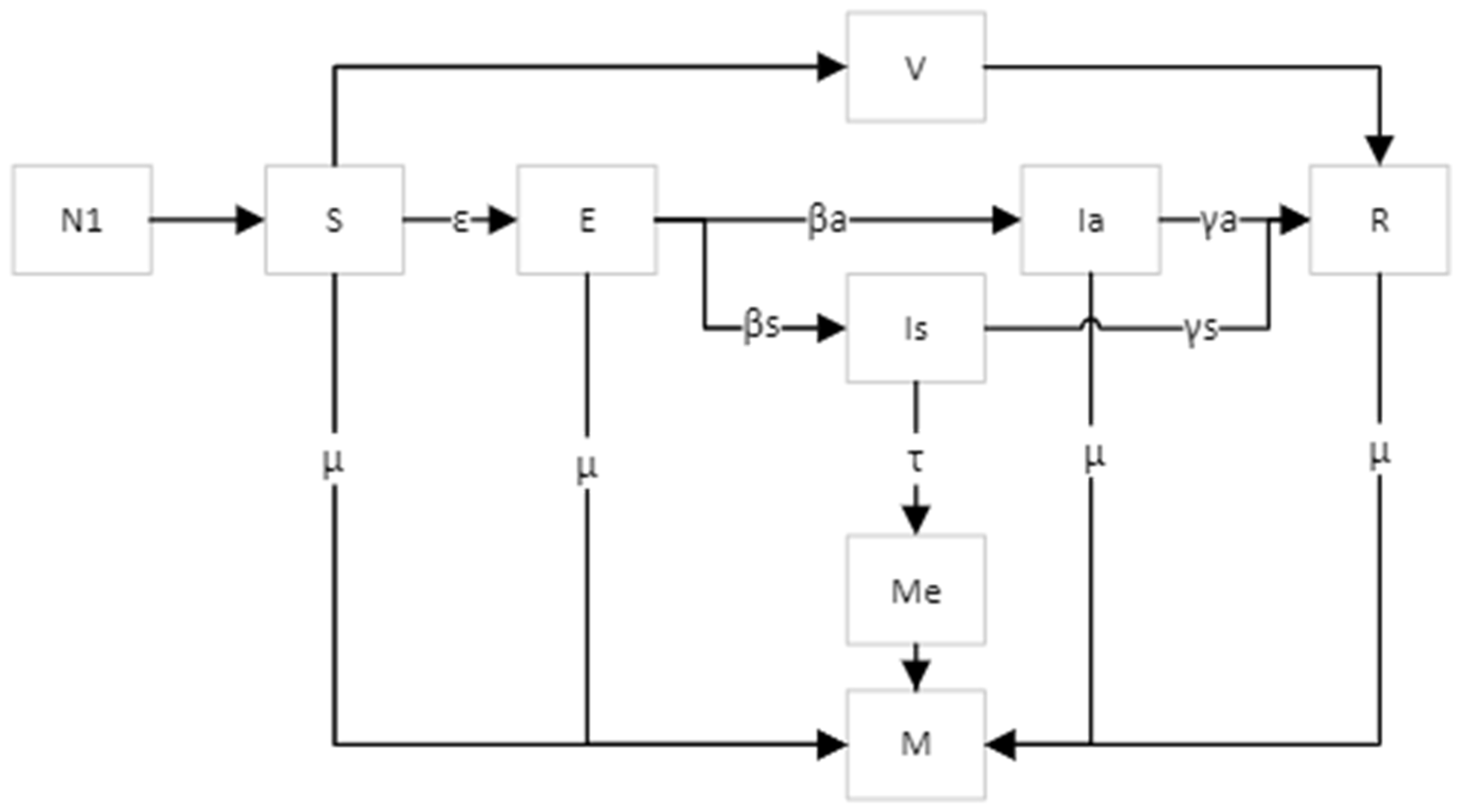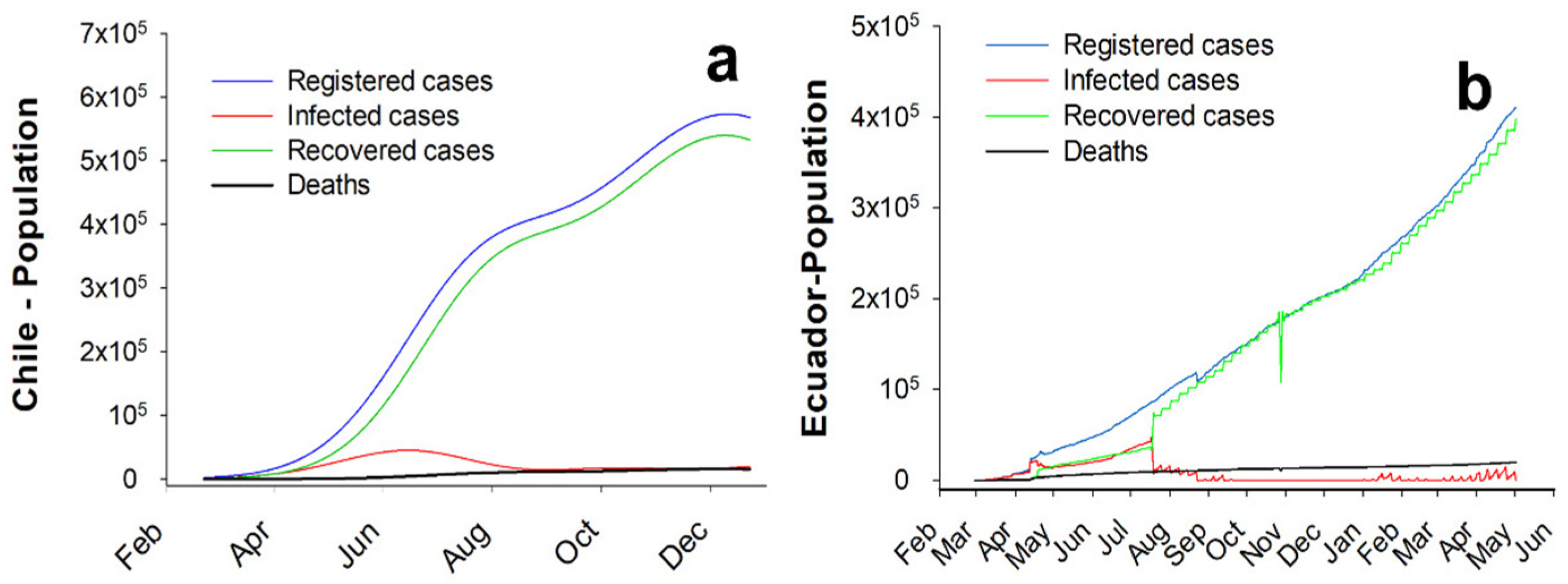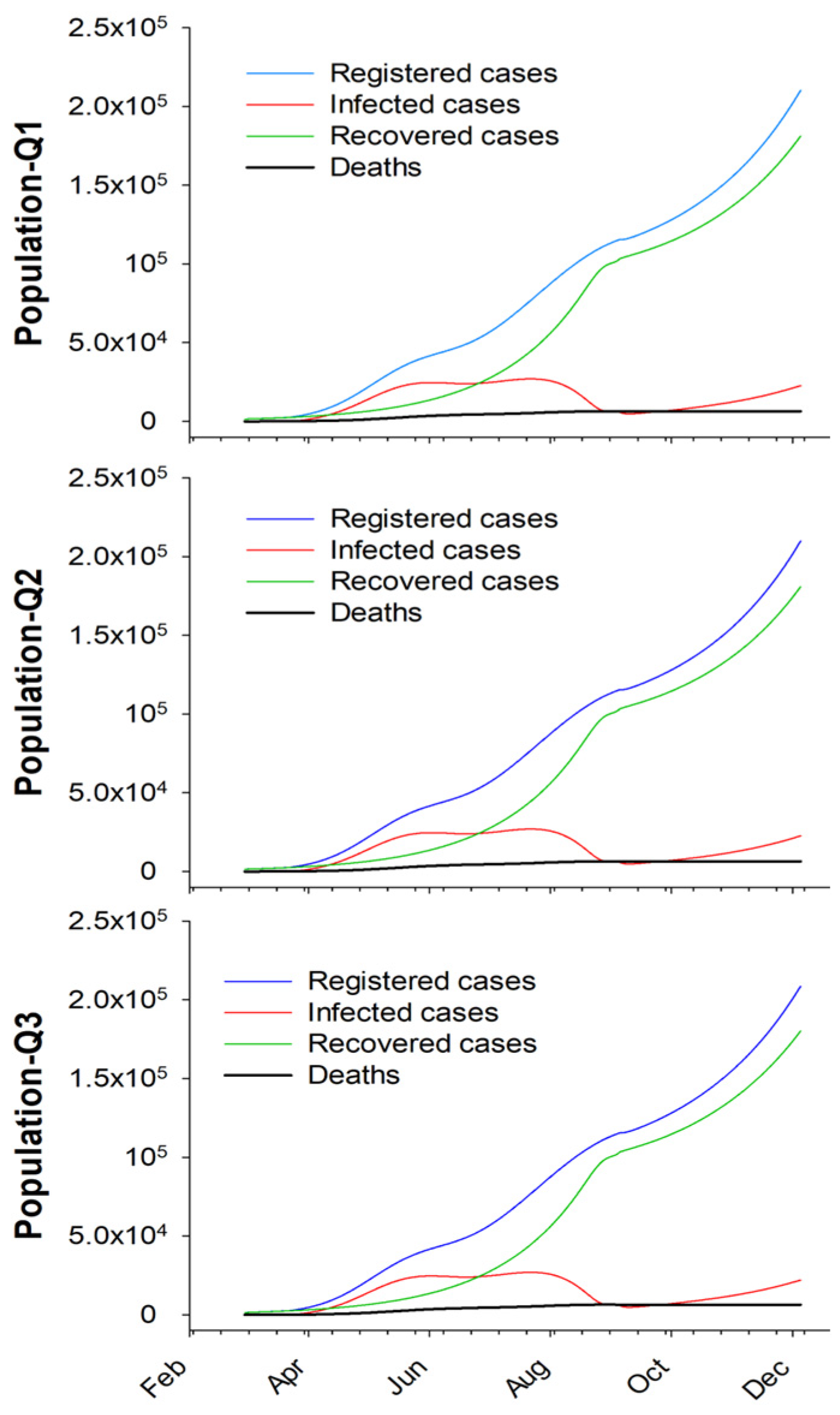Multivariate Forecasting Model for COVID-19 Spread Based on Possible Scenarios in Ecuador
Abstract
:1. Introduction
2. Materials and Methods
2.1. Model Development
2.2. Model Testing
3. Results
3.1. Database Model Testing
3.2. Ecuador Forecast Modelling
4. Discussion
5. Conclusions
Author Contributions
Funding
Data Availability Statement
Acknowledgments
Conflicts of Interest
References
- WHO (World Health Organization). WHO Coronavirus (COVID-19) Dashboard. 2023. Available online: https://covid19.who.int/ (accessed on 5 September 2023).
- Spychalski, P.; Błażyńska-Spychalska, A.; Kobiela, J. Estimating Case Fatality Rates of COVID-19. Lancet Infect. Dis. 2020, 20, 774–775. [Google Scholar] [CrossRef] [PubMed]
- Verity, R.; Okell, L.C.; Dorigatti, I.; Winskill, P.; Whittaker, C.; Imai, N.; Cuomo-Dannenburg, G.; Thompson, H.; Walker, P.G.; Fu, H.; et al. Estimates of the Severity of COVID-19 Disease. MedRxiv 2020, 2020-03. [Google Scholar]
- Gobierno de la República de Ecuador. Estadísticas COVID-19—Coronavirus Ecuador. 2022. Available online: https://www.coronavirusecuador.com/estadisticas-covid-19/ (accessed on 14 January 2022).
- Duque-Rengel, V.K.; Márquez-Domínguez, C.; Calva-Cabrera, K.D.; Zambrano, C.M.B. Comunicación Gubernamental y Redes Sociales Durante La Pandemia de 2020 En Ecuador: Derechos Humanos y Mensajes Educativos. Rev. Ibérica Sist. Tecnol. Informação 2021, 180–198. [Google Scholar]
- Vera, F.; Solórzano, M.; Ochoa, G.; García Bustos, S.; Cevallos, S. Mortality Tables of Continental Ecuador Using a Survival Analysis. Papeles De Población 2018, 24, 63–83. [Google Scholar] [CrossRef]
- Fanelli, D.; Piazza, F. Analysis and Forecast of COVID-19 Spreading in China, Italy and France. Chaos Solitons Fractals 2020, 134, 109761. [Google Scholar] [CrossRef] [PubMed]
- Khajanchi, S.; Sarkar, K.; Mondal, J. Dynamics of the COVID-19 Pandemic in India. arXiv 2020, arXiv:2005.06286. [Google Scholar] [CrossRef]
- Kumar, P.; Kalita, H.; Patairiya, S.; Sharma, Y.D.; Nanda, C.; Rani, M.; Rahmani, J.; Bhagavathula, A.S. Forecasting the Dynamics of COVID-19 Pandemic in Top 15 Countries in April 2020: ARIMA Model with Machine Learning Approach. MedRxiv 2020, 2020-03. [Google Scholar] [CrossRef]
- Samui, P.; Mondal, J.; Khajanchi, S. A Mathematical Model for COVID-19 Transmission Dynamics with a Case Study of India. Chaos Solitons Fractals 2020, 140, 110173. [Google Scholar] [CrossRef]
- Vespignani, A.; Tian, H.; Dye, C.; Lloyd-Smith, J.O.; Eggo, R.M.; Shrestha, M.; Scarpino, S.V.; Gutierrez, B.; Kraemer, M.U.; Wu, J.; et al. Modelling COVID-19. Nat. Rev. Phys. 2020, 2, 279–281. [Google Scholar] [CrossRef]
- Restif, O.; Hayman, D.T.; Pulliam, J.R.; Plowright, R.K.; George, D.B.; Luis, A.D.; Cunningham, A.A.; Bowen, R.A.; Fooks, A.R.; O’Shea, T.J.; et al. Model-Guided Fieldwork: Practical Guidelines for Multidisciplinary Research on Wildlife Ecological and Epidemiological Dynamics. Ecol. Lett. 2012, 15, 1083–1094. [Google Scholar] [CrossRef]
- Alimohamadi, Y.; Taghdir, M.; Sepandi, M. Estimate of the Basic Reproduction Number for COVID-19: A Systematic Review and Meta-Analysis. J. Prev. Med. Public Health 2020, 53, 151–157. [Google Scholar] [CrossRef] [PubMed]
- Kermack, W.O.; McKendrick, A.G. Contributions to the Mathematical Theory of Epidemics–I. 1927. Bull. Math. Biol. 1991, 53, 33–55. [Google Scholar] [PubMed]
- Shaw, C.L.; Kennedy, D.A. What the Reproductive Number R 0 Can and Cannot Tell Us about COVID-19 Dynamics. Theor. Popul. Biol. 2021, 137, 2–9. [Google Scholar] [CrossRef] [PubMed]
- Yuan, J.; Li, M.; Lv, G.; Lu, Z.K. Monitoring Transmissibility and Mortality of COVID-19 in Europe. Int. J. Infect. Dis. 2020, 95, 311–315. [Google Scholar] [CrossRef] [PubMed]
- Delamater, P.L.; Street, E.J.; Leslie, T.F.; Yang, Y.T.; Jacobsen, K.H. Complexity of the Basic Reproduction Number (R0). Emerg. Infect. Dis. 2019, 25, 1. [Google Scholar] [CrossRef] [PubMed]
- Omori, R.; Mizumoto, K.; Chowell, G. Changes in Testing Rates Could Mask the Novel Coronavirus Disease (COVID-19) Growth Rate. Int. J. Infect. Dis. 2020, 94, 116–118. [Google Scholar] [CrossRef] [PubMed]
- Hethcote, H.W. The basic epidemiology models: Models, expressions for R0, parameter estimation, and applications. In Mathematical Understanding of Infectious Disease Dynamics; Lecture Notes Series, Institute for Mathematical Sciences, National University of Singapore; World Scientific: Singapore, 2008; Volume 16, pp. 1–61. ISBN 978-981-283-482-9. [Google Scholar]
- Zhao, J.; Wang, Z.; Dong, Y.; Yang, Z.; Govers, G. How Soil Erosion and Runoff Are Related to Land Use, Topography and Annual Precipitation: Insights from a Meta-Analysis of Erosion Plots in China. Sci. Total Environ. 2022, 802, 149665. [Google Scholar] [CrossRef] [PubMed]
- Zhang, H.; Wei, J.; Yang, Q.; Baartman, J.E.M.; Gai, L.; Yang, X.; Li, S.; Yu, J.; Ritsema, C.J.; Geissen, V. An Improved Method for Calculating Slope Length (λ) and the LS Parameters of the Revised Universal Soil Loss Equation for Large Watersheds. Geoderma 2017, 308, 36–45. [Google Scholar] [CrossRef]
- Ferrari, M.J.; Bjørnstad, O.N.; Dobson, A.P. Estimation and Inference of R0 of an Infectious Pathogen by a Removal Method. Math. Biosci. 2005, 198, 14–26. [Google Scholar] [CrossRef]
- Anderson, R.M.; Heesterbeek, H.; Klinkenberg, D.; Hollingsworth, T.D. How Will Country-Based Mitigation Measures Influence the Course of the COVID-19 Epidemic? Lancet 2020, 395, 931–934. [Google Scholar] [CrossRef]
- Bates, I.; Fenton, C.; Gruber, J.; Lalloo, D.; Lara, A.M.; Squire, S.B.; Theobald, S.; Thomson, R.; Tolhurst, R. Vulnerability to Malaria, Tuberculosis, and HIV/AIDS Infection and Disease. Part 1: Determinants Operating at Individual and Household Level. Lancet Infect. Dis. 2004, 4, 267–277. [Google Scholar] [CrossRef] [PubMed]
- Khalatbari-Soltani, S.; Cumming, R.G.; Delpierre, C.; Kelly-Irving, M. Importance of Collecting Data on Socioeconomic Determinants from the Early Stage of the COVID-19 Outbreak Onwards. J. Epidemiol. Community Health 2020, 74, 620–623. [Google Scholar] [CrossRef] [PubMed]
- Liang, J.; Zhang, X.; Wang, K.; Tang, M.; Tian, M. Discovering Dynamic Models of COVID-19 Transmission. Transbounding Emerg. Dis. 2022, 69, e64–e70. [Google Scholar] [CrossRef] [PubMed]
- Wang, M.; Flessa, S. Modelling COVID-19 under Uncertainty: What Can We Expect? Eur. J. Health Econ. 2020, 21, 665–668. [Google Scholar] [CrossRef] [PubMed]
- Rachah, A.; Torres, D.F. Mathematical Modelling, Simulation, and Optimal Control of the 2014 Ebola Outbreak in West Africa. Discret. Dyn. Nat. Soc. 2015, 2015, 842792. [Google Scholar] [CrossRef]
- Hamzah, F.B.; Lau, C.; Nazri, H.; Ligot, D.V.; Lee, G.; Tan, C.L.; Shaib, M.; Zaidon, U.H.B.; Abdullah, A.B.; Chung, M.H.; et al. CoronaTracker: Worldwide COVID-19 Outbreak Data Analysis and Prediction. Bull. World Health Organ. 2020, 1, 1–32. [Google Scholar] [CrossRef]
- BBC News Mundo. Coronavirus: ¿cuándo Una Persona Enferma de COVID-19 Deja de Ser Contagiosa (Tenga o No Síntomas)? 2021. Available online: https://www.bbc.com/mundo/noticias-55988371 (accessed on 21 October 2021).
- Gobierno de Chile. Cifras: Situación Nacional Del COVID-19 En Chile 2020. Available online: https://www.gob.cl/pasoapaso/cifrasoficiales/#datos (accessed on 21 October 2021).
- Robert, C.P.; Casella, G. Monte Carlo Statistical Methods, 2nd ed.; Springer: New York, NY, USA, 2004; Volume 2. [Google Scholar]
- El Universo Casos de Coronavirus En Ecuador, al Jueves 3 de Diciembre: 195.884 Confirmados y 13.612 Fallecidos 2020. Available online: https://www.eluniverso.com/noticias/2020/12/03/nota/8070727/coronavirus-covid19-ecuador-casos-contagios-muertes-3-diciembre/ (accessed on 21 October 2021).
- Harjule, P.; Tiwari, V.; Kumar, A. Mathematical Models to Predict COVID-19 Outbreak: An Interim Review. J. Interdiscip. Math. 2021, 24, 259–284. [Google Scholar] [CrossRef]
- Muniyappan, A.; Sundarappan, B.; Manoharan, P.; Hamdi, M.; Raahemifar, K.; Bourouis, S.; Varadarajan, V. Stability and Numerical Solutions of Second Wave Mathematical Modeling on COVID-19 and Omicron Outbreak Strategy of Pandemic: Analytical and Error Analysis of Approximate Series Solutions by Using HPM. Mathematics 2022, 10, 343. [Google Scholar] [CrossRef]
- Ní Fhloinn, E.; Fitzmaurice, O. Challenges and Opportunities: Experiences of Mathematics Lecturers Engaged in Emergency Remote Teaching during the COVID-19 Pandemic. Mathematics 2021, 9, 2303. [Google Scholar] [CrossRef]
- Pinter, G.; Felde, I.; Mosavi, A.; Ghamisi, P.; Gloaguen, R. COVID-19 Pandemic Prediction for Hungary; A Hybrid Machine Learning Approach. Mathematics 2020, 8, 890. [Google Scholar] [CrossRef]
- Saleem, F.; AL-Ghamdi, A.S.A.-M.; Alassafi, M.O.; AlGhamdi, S.A. Machine Learning, Deep Learning, and Mathematical Models to Analyze Forecasting and Epidemiology of COVID-19: A Systematic Literature Review. Int. J. Environ. Res. Public Health 2022, 19, 5099. [Google Scholar] [CrossRef] [PubMed]
- Vytla, V.; Ramakuri, S.K.; Peddi, A.; Srinivas, K.K.; Ragav, N.N. Mathematical Models for Predicting COVID-19 Pandemic: A Review. J. Phys. Conf. Ser. 2021, 1797, 012009. [Google Scholar] [CrossRef]
- Xie, G. A Novel Monte Carlo Simulation Procedure for Modelling COVID-19 Spread over Time. Sci. Rep. 2020, 10, 13120. [Google Scholar] [CrossRef] [PubMed]
- Egger, M.; Johnson, L.; Althaus, C.; Schöni, A.; Salanti, G.; Low, N.; Norris, S.L. Developing WHO Guidelines: Time to Formally Include Evidence from Mathematical Modelling Studies. F1000Research 2017, 6, 1584. [Google Scholar] [CrossRef] [PubMed]
- James, L.P.; Salomon, J.A.; Buckee, C.O.; Menzies, N.A. The Use and Misuse of Mathematical Modeling for Infectious Disease Policymaking: Lessons for the COVID-19 Pandemic. Med. Decis. Mak. 2021, 41, 379–385. [Google Scholar] [CrossRef] [PubMed]
- Liu, S.L.; Dong, Y.H.; Li, D.; Liu, Q.; Wang, J.; Zhang, X.L. Effects of Different Terrace Protection Measures in a Sloping Land Consolidation Project Targeting Soil Erosion at the Slope Scale. Ecol. Eng. 2013, 53, 46–53. [Google Scholar] [CrossRef]
- Wu, J.T.; Leung, K.; Leung, G.M. Nowcasting and Forecasting the Potential Domestic and International Spread of the 2019-nCoV Outbreak Originating in Wuhan, China: A Modelling Study. Lancet 2020, 395, 689–697. [Google Scholar] [CrossRef]
- Musa, S.S.; Zhao, S.; Wang, M.H.; Habib, A.G.; Mustapha, U.T.; He, D. Estimation of Exponential Growth Rate and Basic Reproduction Number of the Coronavirus Disease 2019 (COVID-19) in Africa. Infect. Dis. Poverty 2020, 9, 96. [Google Scholar] [CrossRef]
- Sy, K.T.L.; White, L.F.; Nichols, B.E. Population Density and Basic Reproductive Number of COVID-19 across United States Counties. PLoS ONE 2021, 16, e0249271. [Google Scholar] [CrossRef]
- Crokidakis, N. Modeling the Early Evolution of the COVID-19 in Brazil: Results from a Susceptible–Infectious–Quarantined–Recovered (SIQR) Model. Int. J. Mod. Phys. C 2020, 31, 2050135. [Google Scholar] [CrossRef]
- Fernández-Naranjo, R.P.; Vásconez-González, E.; Simbaña-Rivera, K.; Gómez-Barreno, L.; Izquierdo-Condoy, J.S.; Cevallos-Robalino, D.; Ortiz-Prado, E. Statistical Data Driven Approach of COVID-19 in Ecuador: R 0 and R t Estimation via New Method. Infect. Dis. Model. 2021, 6, 232–243. [Google Scholar] [CrossRef] [PubMed]
- Espinosa, P.; Quirola-Amores, P.; Teran, E. Application of a Susceptible, Infectious, and/or Recovered (SIR) Model to the COVID-19 Pandemic in Ecuador. Front. Appl. Math. Stat. 2020, 6, 571544. [Google Scholar] [CrossRef]
- Breban, R.; Riou, J.; Fontanet, A. Interhuman Transmissibility of Middle East Respiratory Syndrome Coronavirus: Estimation of Pandemic Risk. Lancet 2013, 382, 694–699. [Google Scholar] [CrossRef] [PubMed]
- Gumel, A.B.; Ruan, S.; Day, T.; Watmough, J.; Brauer, F.; Van den Driessche, P.; Gabrielson, D.; Bowman, C.; Alexander, M.E.; Ardal, S.; et al. Modelling Strategies for Controlling SARS Outbreaks. Proc. R. Soc. Lond. Ser. B Biol. Sci. 2004, 271, 2223–2232. [Google Scholar] [CrossRef] [PubMed]
- Liu, Y.; Gayle, A.A.; Wilder-Smith, A.; Rocklöv, J. The Reproductive Number of COVID-19 Is Higher Compared to SARS Coronavirus. J. Travel Med. 2020, 27, taaa021. [Google Scholar] [CrossRef] [PubMed]
- Bustamante-Orellana, C.; Cevallos-Chavez, J.; Montalvo-Clavijo, C.; Sullivan, J.; Michael, E.; Mubayi, A. Modeling and Preparedness: The Transmission Dynamics of COVID-19 Outbreak in Provinces of Ecuador. MedRxiv 2020. [Google Scholar] [CrossRef]
- Vigl, J.; Strauss, H.; Talamini, F.; Zentner, M. Relationship Satisfaction in the Early Stages of the COVID-19 Pandemic: A Cross-National Examination of Situational, Dispositional, and Relationship Factors. PLoS ONE 2022, 17, e0264511. [Google Scholar] [CrossRef] [PubMed]
- Blumberg, S.; Lloyd-Smith, J.O. Comparing Methods for Estimating R0 from the Size Distribution of Subcritical Transmission Chains. Epidemics 2013, 5, 131–145. [Google Scholar] [CrossRef]
- Pandit, J. Managing the R0 of COVID-19: Mathematics Fights Back. Anaesthesia 2020, 75, 1643. [Google Scholar] [CrossRef]
- Oraby, T.; Tyshenko, M.G.; Maldonado, J.C.; Vatcheva, K.; Elsaadany, S.; Alali, W.Q.; Longenecker, J.C.; Al-Zoughool, M. Modeling the Effect of Lockdown Timing as a COVID-19 Control Measure in Countries with Differing Social Contacts. Sci. Rep. 2021, 11, 3354. [Google Scholar] [CrossRef]
- Shafer, L.A.; Nesca, M.; Balshaw, R. Relaxation of Social Distancing Restrictions: Model Estimated Impact on COVID-19 Epidemic in Manitoba, Canada. PLoS ONE 2021, 16, e0244537. [Google Scholar] [CrossRef]
- He, D.; Zhao, S.; Xu, X.; Lin, Q.; Zhuang, Z.; Cao, P.; Wang, M.H.; Lou, Y.; Xiao, L.; Wu, Y.; et al. Low Dispersion in the Infectiousness of COVID-19 Cases Implies Difficulty in Control. BMC Public Health 2020, 20, 1558. [Google Scholar] [CrossRef]
- Henry, B.F. Social Distancing and Incarceration: Policy and Management Strategies to Reduce COVID-19 Transmission and Promote Health Equity through Decarceration. Health Educ. Behav. 2020, 47, 536–539. [Google Scholar] [CrossRef]
- Sun, C.; Zhai, Z. The Efficacy of Social Distance and Ventilation Effectiveness in Preventing COVID-19 Transmission. Sustain. Cities Soc. 2020, 62, 102390. [Google Scholar] [CrossRef]
- Łukasik, M.; Porębska, A. Responsiveness and Adaptability of Healthcare Facilities in Emergency Scenarios: COVID-19 Experience. Int. J. Environ. Res. Public Health 2022, 19, 675. [Google Scholar] [CrossRef] [PubMed]



| Test | Cases | Mean | Homogenous Groups |
|---|---|---|---|
| Chile 25% (Q1)-3 | 306 | 170,128 | A |
| Chile 25% (Q1)-2 | 306 | 171,818 | A |
| Chile 25%(Q1)-1 | 306 | 175,680 | A |
| Chile 50% (Q2)-2 | 306 | 279,780 | B |
| Chile 50%(Q2)-3 | 306 | 281,193 | B |
| Chile 50%(Q2)-1 | 306 | 281,381 | B |
| Chile 75%(Q3)-2 | 306 | 290,504 | B |
| Chile 75%(Q3)-3 | 306 | 290,632 | B |
| Chile 75% (Q3)-1 | 306 | 290,687 | B |
| Chile Real Data | 306 | 298,163 | B |
| Forecast | Q1 1 | Q1 2 | Q1 3 | Q2 1 | Q2 2 | Q2 3 | Q3 1 | Q3 2 | Q3 3 |
|---|---|---|---|---|---|---|---|---|---|
| Mean Absolute Error (%) | 47.47 | 48.38 | 48.85 | 8.47 | 8.62 | 8.41 | 6.33 | 6.39 | 6.34 |
| Mean Forecast Error (population × 1000) | 163.61 | 168.77 | 171.03 | 33.25 | 36.50 | 33.64 | 32.02 | 32.76 | 32.24 |
| Biosecurity Measures * [%] | Exposed Population | Ro | Confirmed Cases [Million] | Deaths | Infected Population [%] | |
|---|---|---|---|---|---|---|
| Wash hands | 90 | 25% | 3.4227 | 4.04 | 54,312 | 23.21 |
| Antiseptic gel | 90 | |||||
| Social distance (2 m) | 51 | |||||
| Face mask | 80 | |||||
| Globes | 10 | 50% | 3.6173 | 8.04 | 101,131 | 46.25 |
| Face shield | 10 | 75% | 3.2204 | 12.05 | 142,285 | 69.28 |
Disclaimer/Publisher’s Note: The statements, opinions and data contained in all publications are solely those of the individual author(s) and contributor(s) and not of MDPI and/or the editor(s). MDPI and/or the editor(s) disclaim responsibility for any injury to people or property resulting from any ideas, methods, instructions or products referred to in the content. |
© 2023 by the authors. Licensee MDPI, Basel, Switzerland. This article is an open access article distributed under the terms and conditions of the Creative Commons Attribution (CC BY) license (https://creativecommons.org/licenses/by/4.0/).
Share and Cite
Guamán, J.; Portilla, K.; Arias-Muñoz, P.; Jácome, G.; Cabrera, S.; Álvarez, L.; Batallas, B.; Cadena, H.; García, J.C. Multivariate Forecasting Model for COVID-19 Spread Based on Possible Scenarios in Ecuador. Mathematics 2023, 11, 4721. https://doi.org/10.3390/math11234721
Guamán J, Portilla K, Arias-Muñoz P, Jácome G, Cabrera S, Álvarez L, Batallas B, Cadena H, García JC. Multivariate Forecasting Model for COVID-19 Spread Based on Possible Scenarios in Ecuador. Mathematics. 2023; 11(23):4721. https://doi.org/10.3390/math11234721
Chicago/Turabian StyleGuamán, Juan, Karen Portilla, Paúl Arias-Muñoz, Gabriel Jácome, Santiago Cabrera, Luis Álvarez, Bolívar Batallas, Hernán Cadena, and Juan Carlos García. 2023. "Multivariate Forecasting Model for COVID-19 Spread Based on Possible Scenarios in Ecuador" Mathematics 11, no. 23: 4721. https://doi.org/10.3390/math11234721
APA StyleGuamán, J., Portilla, K., Arias-Muñoz, P., Jácome, G., Cabrera, S., Álvarez, L., Batallas, B., Cadena, H., & García, J. C. (2023). Multivariate Forecasting Model for COVID-19 Spread Based on Possible Scenarios in Ecuador. Mathematics, 11(23), 4721. https://doi.org/10.3390/math11234721










